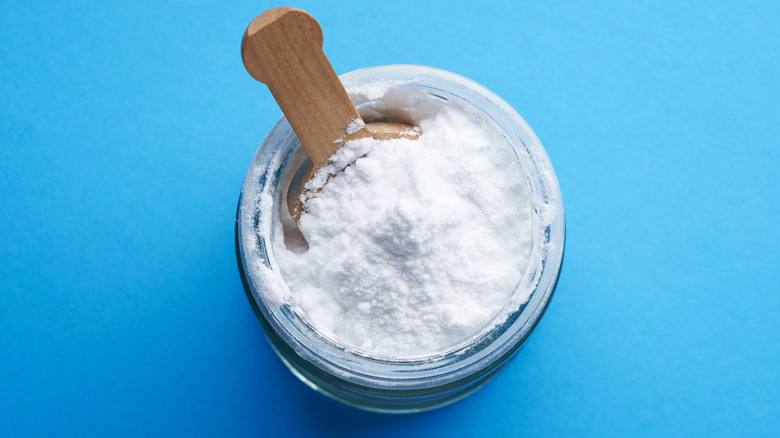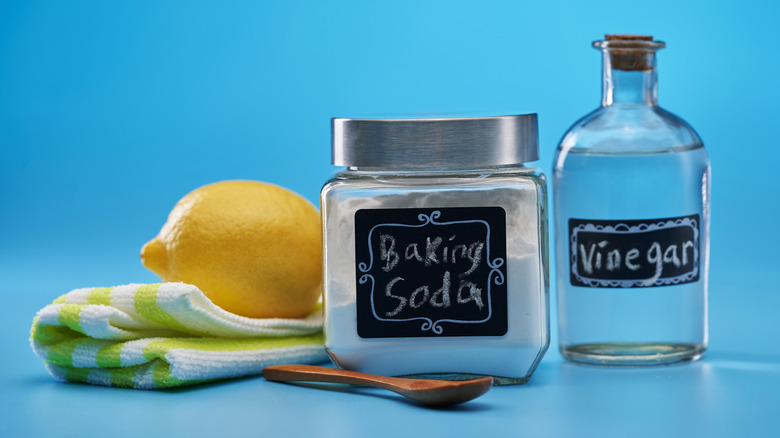The Science Behind How Baking Soda Works In Recipes
If you take a look inside the pantry, there's a very high chance that among all of the condiments, cooking oils, and your very own selection of teas, you'll spot a box of baking soda tucked away in the back. And it's not that hard to understand why, since this leavening agent is unbelievably versatile. Whether used as a mouthwash, an air freshener, or as the key to cleaning your coffee maker, baking soda is a marvelous little kitchen treasure, isn't it?
It's of course no different when it comes to baking (as if its name didn't already make that clear enough). A single peek into that dessert recipe book — the one you keep hidden in your kitchen drawer — and you'll most probably find baking soda listed in the majority of the recipes. But why is that, though?
Naturally, at this point, your mind can't help but drift back to those high school chemistry classes, but you still can't quite figure out how this fine, white powder just makes every baked good taste better. Let's break that down, shall we? Baking soda is simply the common name for sodium bicarbonate — NaHCO₃ for all the science geeks out there. And once it comes into contact with an acid or a liquid, it starts producing carbon dioxide (CO₂). Alright, you might be thinking, but how does that actually help with baking?
What makes baking soda so effective?
Let's say you find that old recipe book and instantly catch a whiff of its vanilla scent (a trait apparently shared between many old books). And with all the memories the scent brings back, you decide to bake a vanilla cake. Now, aside from one of the ingredients being baking powder — which you already know how to substitute with the perfect ratio of baking soda – the recipe also includes buttermilk.
This is the catch: acidic liquids, such as buttermilk, or even lemon or vinegar, are what prompt the baking soda to react and release carbon dioxide. And since the reaction starts ASAP, it's crucial to immediately put the pan with the batter into a preheated oven. This not only helps the bubbles form properly but also makes your cake come out perfectly soft and spongy.
From a scientific point of view, it all boils down to a single reaction called neutralization. And don't let its name scare you; it's simply what happens when an alkaline ingredient such as baking soda interacts with an acidic one. Carbon dioxide, a byproduct of the reaction, then spreads through the dough and causes it to rise.
That said, it's slightly different with cookie dough, where the reaction doesn't really start until the butter melts from the oven's heat. The reason for this is that cookie dough acidity usually comes from non-liquid ingredients like brown sugar, which in turn gets its acidic kick from cane molasses.
But wait, there's more
With sweet treats, it's important to religiously stick to the recipe. In other words, don't overuse baking soda, because in this case more does not equal merry. This is because it could leave you with a soapy-tasting cake, or send you into panic mode about what to do if you add too much baking soda.
Using just the right amount of it is essential, as it increases the dough's pH, which in turn allows it to evenly develop under alkaline conditions. In cookie terms, this means they remain tender thanks to the baking soda weakening the gluten, which can otherwise reduce their spread time, as suggested in research published in the journal Foods.
One way or another, baking soda is key, whether you're preparing Christmas cookies, banana bread, or choosing a quick microwave chocolate cake when you're feeling too lazy to bake a real one. Baking soda is likely one of the easiest ingredients to find in the supermarket, but storing it properly is a must to make sure it does the job in whichever one of your recipes. While unopened, it can last up to three years if stored somewhere dry. In contrast, once out of the box, its shelf life reduces to 6 months if kept away from moisture.


